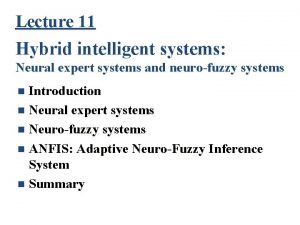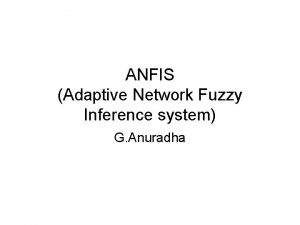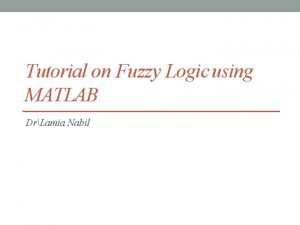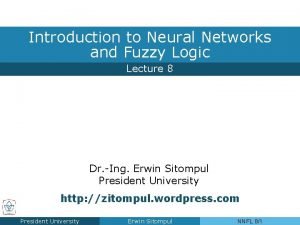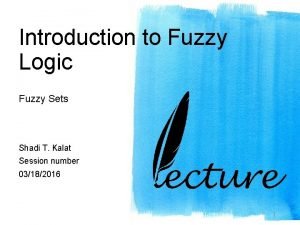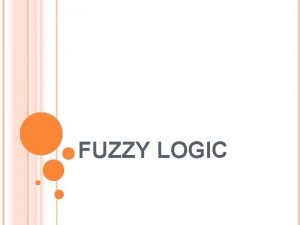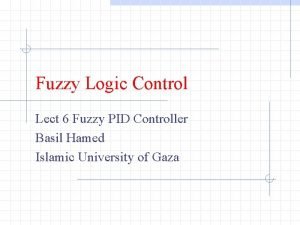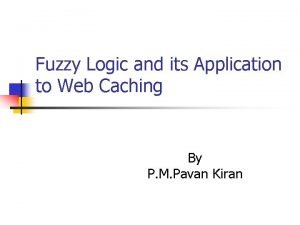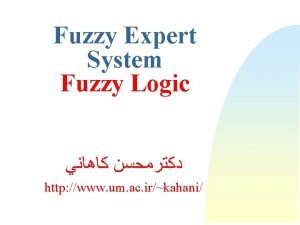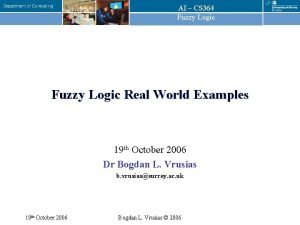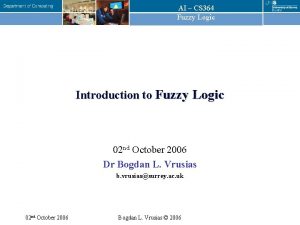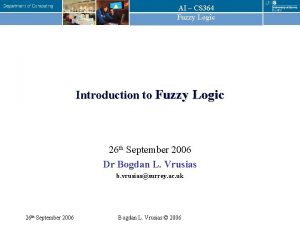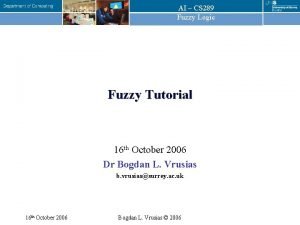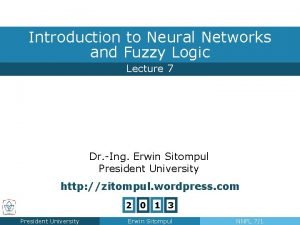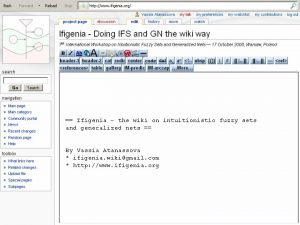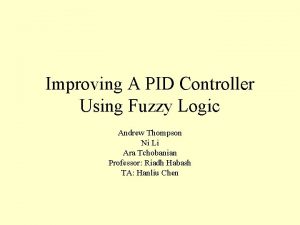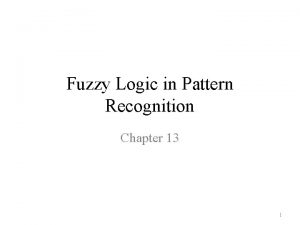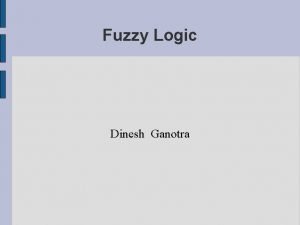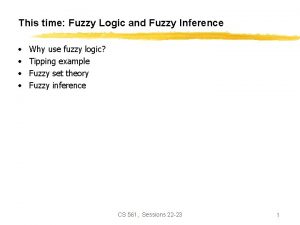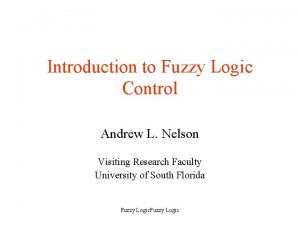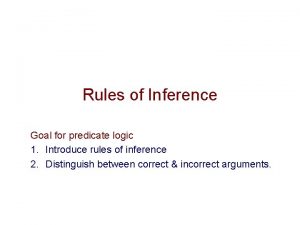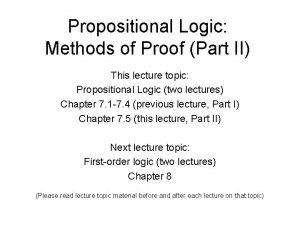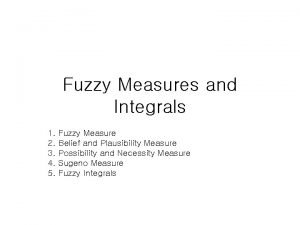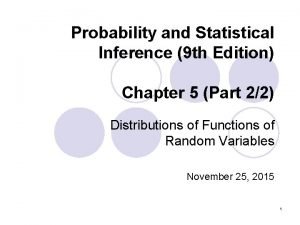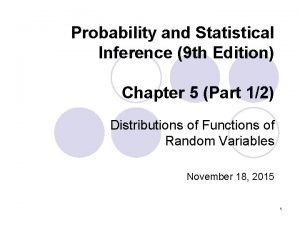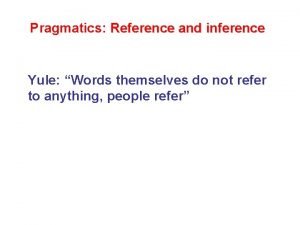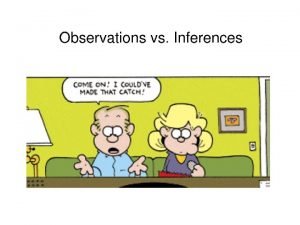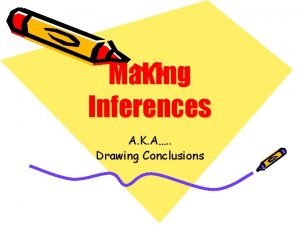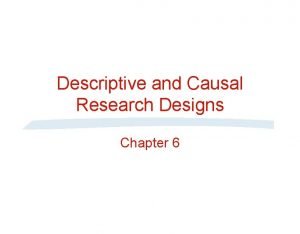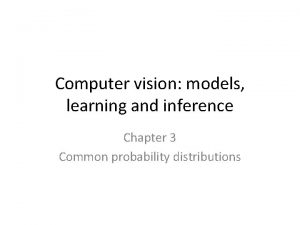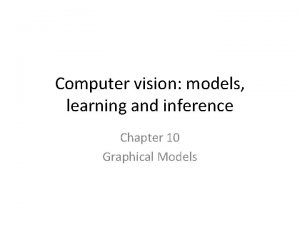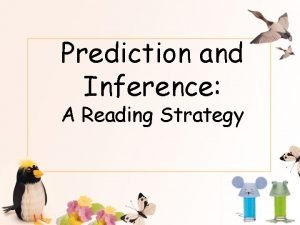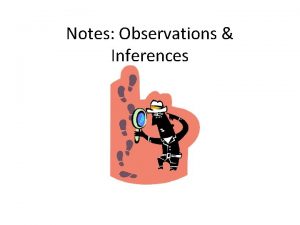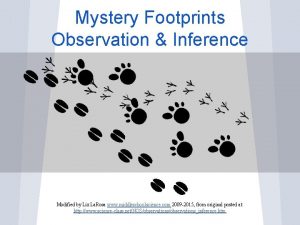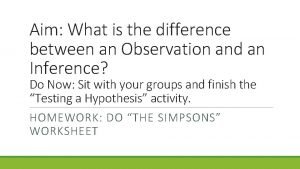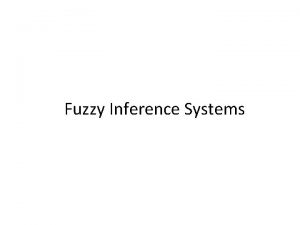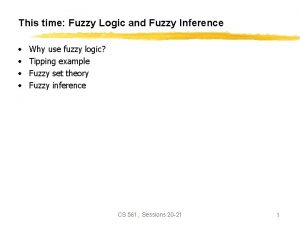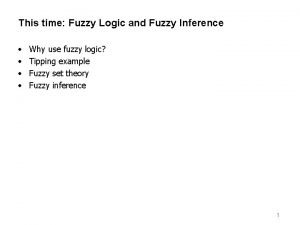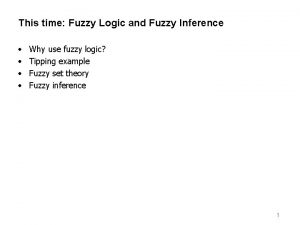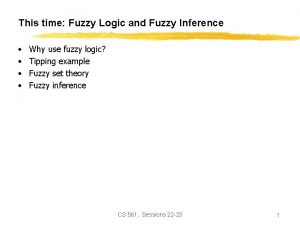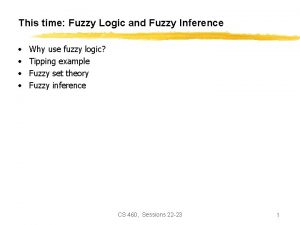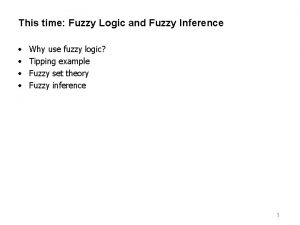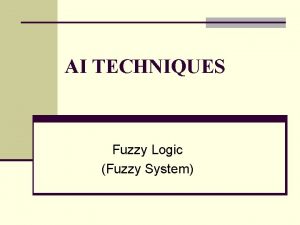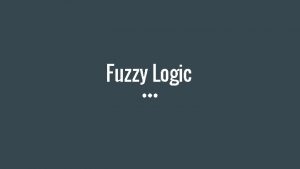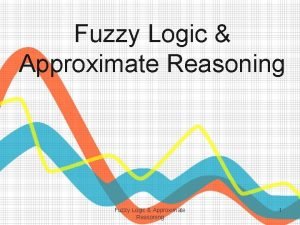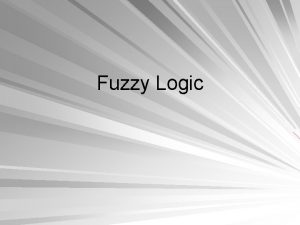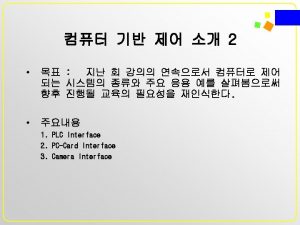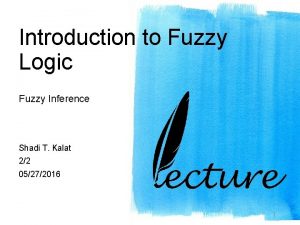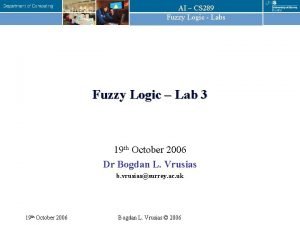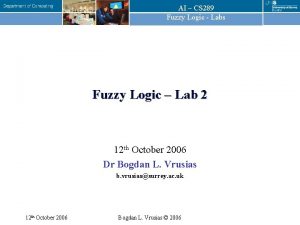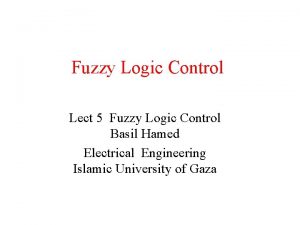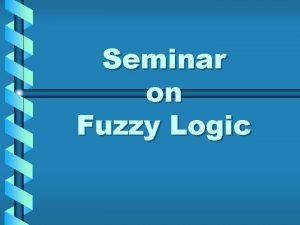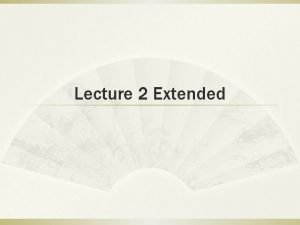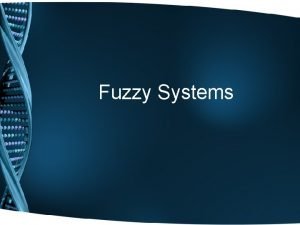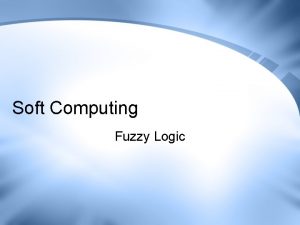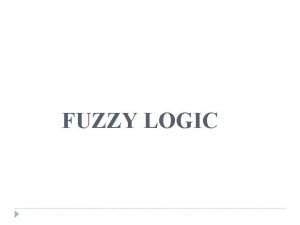This time Fuzzy Logic and Fuzzy Inference Why


























































- Slides: 58

This time: Fuzzy Logic and Fuzzy Inference • • Why use fuzzy logic? Tipping example Fuzzy set theory Fuzzy inference CS 460, Sessions 22 -23 1

What is fuzzy logic? • A super set of Boolean logic • Builds upon fuzzy set theory • Graded truth. Truth values between True and False. Not everything is either/or, true/false, black/white, on/off etc. • Grades of membership. Class of tall men, class of far cities, class of expensive things, etc. • Lotfi Zadeh, UC/Berkely 1965. Introduced FL to model uncertainty in natural language. Tall, far, nice, large, hot, … • Reasoning using linguistic terms. Natural to express expert knowledge. If the weather is cold then wear warm clothing CS 460, Sessions 22 -23 2

Why use fuzzy logic? Pros: • • • Conceptually easy to understand w/ “natural” maths Tolerant of imprecise data Universal approximation: can model arbitrary nonlinear functions Intuitive Based on linguistic terms Convenient way to express expert and common sense knowledge Cons: • Not a cure-all • Crisp/precise models can be more efficient and even convenient • Other approaches might be formally verified to work CS 460, Sessions 22 -23 3

Tipping example • The Basic Tipping Problem: Given a number between 0 and 10 that represents the quality of service at a restaurant what should the tip be? Cultural footnote: An average tip for a meal in the U. S. is 15%, which may vary depending on the quality of the service provided. CS 460, Sessions 22 -23 4

Tipping example: The non-fuzzy approach • Tip = 15% of total bill • What about quality of service? CS 460, Sessions 22 -23 5

Tipping example: The non-fuzzy approach • • Tip = linearly proportional to service from 5% to 25% tip = 0. 20/10*service+0. 05 What about quality of the food? CS 460, Sessions 22 -23 6

Tipping example: Extended • The Extended Tipping Problem: Given a number between 0 and 10 that represents the quality of service and the quality of the food, at a restaurant, what should the tip be? How will this affect our tipping formula? CS 460, Sessions 22 -23 7

Tipping example: The non-fuzzy approach • Tip = 0. 20/20*(service+food)+0. 05 • We want service to be more important than food quality. E. g. , 80% for service and 20% for food. CS 460, Sessions 22 -23 8

Tipping example: The non-fuzzy approach • • Tip = serv. Ratio*(. 2/10*(service)+. 05) + (1 -serv. Ratio)*(. 2/10*(food)+0. 05); serv. Ratio = 80% Seems too linear. Want 15% tip in general and deviation only for exceptionally good or bad service. CS 460, Sessions 22 -23 9

Tipping example: The non-fuzzy approach if service < 3, tip(f+1, s+1) = serv. Ratio*(. 1/3*(s)+. 05) +. . . (1 -serv. Ratio)*(. 2/10*(f)+0. 05); elseif s < 7, tip(f+1, s+1) = serv. Ratio*(. 15) +. . . (1 -serv. Ratio)*(. 2/10*(f)+0. 05); else, tip(f+1, s+1) = serv. Ratio*(. 1/3*(s-7)+. 15) +. . . (1 -serv. Ratio)*(. 2/10*(f)+0. 05); end; CS 460, Sessions 22 -23 10

Tipping example: The non-fuzzy approach Nice plot but • ‘Complicated’ function • Not easy to modify • Not intuitive • Many hard-coded parameters • Not easy to understand CS 460, Sessions 22 -23 11

Tipping problem: the fuzzy approach What we want to express is: 1. 2. 3. 4. 5. or 1. 2. 3. If service is poor then tip is cheap If service is good the tip is average If service is excellent then tip is generous If food is rancid then tip is cheap If food is delicious then tip is generous If service is poor or the food is rancid then tip is cheap If service is good then tip is average If service is excellent or food is delicious then tip is generous We have just defined the rules for a fuzzy logic system. CS 460, Sessions 22 -23 12

Tipping problem: fuzzy solution Decision function generated using the 3 rules. CS 460, Sessions 22 -23 13

Tipping problem: fuzzy solution • Before we have a fuzzy solution we need to find out a) how to define terms such as poor, delicious, cheap, generous etc. b) how to combine terms using AND, OR and other connectives c) how to combine all the rules into one final output CS 460, Sessions 22 -23 14

Fuzzy sets • Boolean/Crisp set A is a mapping for the elements of S to the set {0, 1}, i. e. , A: S {0, 1} • Characteristic function: A(x) = { 1 if x is an element of set A 0 if x is not an element of set A • Fuzzy set F is a mapping for the elements of S to the interval [0, 1], i. e. , F: S [0, 1] • Characteristic function: 0 F(x) 1 • 1 means full membership, 0 means no membership and anything in between, e. g. , 0. 5 is called graded membership CS 460, Sessions 22 -23 15

Example: Crisp set Tall • Fuzzy sets and concepts are commonly used in natural language John is tall Dan is smart Alex is happy The class is hot • E. g. , the crisp set Tall can be defined as {x | height x > 1. 8 meters} But what about a person with a height = 1. 79 meters? What about 1. 78 meters? … What about 1. 52 meters? CS 460, Sessions 22 -23 16

Example: Fuzzy set Tall • In a fuzzy set a person with a height of 1. 8 meters would be considered tall to a high degree A person with a height of 1. 7 meters would be considered tall to a lesser degree etc. • The function can change for basketball players, Danes, women, children etc. CS 460, Sessions 22 -23 17

Membership functions: S-function • The S-function can be used to define fuzzy sets • S(x, a, b, c) = • • 0 2(x-a/c-a)2 1 – 2(x-c/c-a)2 1 for x a for a x b for b x c for x c a b c CS 460, Sessions 22 -23 18

Membership functions: P-Function • P(x, a, b) = • S(x, b-a/2, b) • 1 – S(x, b, b+a/2, a+b) for x b E. g. , close (to a) a b-a/2 a b+a/2 CS 460, Sessions 22 -23 b+a 19

Simple membership functions • Piecewise linear: triangular etc. • Easier to represent and calculate saves computation CS 460, Sessions 22 -23 20

Fuzzy Sets 1 Membership Grade Cold Mild Warm 0 30 CS 460, Sessions 22 -23 60 °F 21

Observation An observed temperature of 38 is cold with a belief of 0. 14, Mild with a belief of 0. 85 and warm with a belief of 0 0. 85 1 Cold Mild Warm 0. 14 0 30 38° CS 460, Sessions 22 -23 60 °F 22

Other representations of fuzzy sets • A finite set of elements: F = 1/x 1 + 2/x 2 + … n/xn + means (Boolean) set union • For example: TALL = {0/1. 0, 0/1. 2, 0/1. 4, 0. 2/1. 6, 0. 8/1. 7, 1. 0/1. 8} CS 460, Sessions 22 -23 23

Fuzzy set operators • Equality A=B A (x) = B (x) • Complement A’ A’ (x) = 1 - A(x) • Containment A B A (x) B (x) • Union A B A B (x) = max( A (x), B (x)) • Intersection A B A B (x) = min( A (x), B (x)) for all x X for all x X CS 460, Sessions 22 -23 24

Example fuzzy set operations A’ A A B A B CS 460, Sessions 22 -23 25

Linguistic Hedges • Modifying the meaning of a fuzzy set using hedges such as very, more or less, slightly, etc. • “Very F “= F 2 • “More or less F “= F • etc. tall 1/2 More or less tall CS 460, Sessions 22 -23 Very tall 26

Fuzzy relations • A fuzzy relation for N sets is defined as an extension of the crisp relation to include the membership grade. R = { R(x 1, x 2, … x. N)/(x 1, x 2, … x. N) | xi X, i=1, … N} which associates the membership grade, R , of each tuple. • E. g. Friend = {0. 9/(Manos, Nacho), 0. 1/(Manos, Dan), 0. 8/(Alex, Mike), 0. 3/(Alex, John)} CS 460, Sessions 22 -23 27

Fuzzy inference • • • Fuzzy logical operations Fuzzy rules Fuzzification Implication Aggregation Defuzzification CS 460, Sessions 22 -23 28

Fuzzy logical operations • AND, OR, NOT, etc. • NOT A = A’ = 1 - A(x) • A AND B = A B = min( A (x), B (x)) • A OR B = A B = max( A (x), B (x)) min(A, B) From the following truth tables it is seen that fuzzy logic is a superset of Boolean logic. max(A, B) 1 -A A B A and B A or B A not A 0 0 0 0 1 1 1 0 0 1 2 1 1 1 CS 460, Sessions 22 -23 29

If-Then Rules • Use fuzzy sets and fuzzy operators as the subjects and verbs of fuzzy logic to form rules. if x is A then y is B where A and B are linguistic terms defined by fuzzy sets on the sets X and Y respectively. This reads if x == A then y = B CS 460, Sessions 22 -23 30

Evaluation of fuzzy rules • In Boolean logic: p q if p is true then q is true • In fuzzy logic: p q if p is true to some degree then q is true to some degree. 0. 5 p => 0. 5 q (partial premise implies partially) • How? CS 460, Sessions 22 -23 31

Fuzzy Rules • Example: “If our distance to the car in front is small, and the distance is decreasing slowly, then decelerate quite hard” • Fuzzy variables in blue • Fuzzy sets in red • QUESTION: Given the distance and the change in the distance, what acceleration should we select? CS 460, Sessions 22 -23 32

Fuzzification: Set Definitions v. small perfect big v. big brake distance << < = > slow present fastest acceleration >> Delta (distance change) CS 460, Sessions 22 -23 33

Fuzzification: Instance observation v. small perfect big v. big brake distance << < = > >> delta observation slow present ? ? fastest acceleration • Distance could be considered small or perfect • Delta could be stable or growing • What acceleration? CS 460, Sessions 22 -23 34

Fuzzification: Instance v. small perfect big v. big o. 55 distance IF distance is Small THEN Slow Down CS 460, Sessions 22 -23 35

Rule Evaluation brake slow present fastest small o. 55 distance acceleration Distance is small, then you slow down. Question: What is the weight to slow down? CS 460, Sessions 22 -23 36

Rule Evaluation slow small o. 55 distance acceleration Clipping approach (others are possible): Clip the fuzzy set for “slow” (the consequent) at the height given by our belief in the premises (0. 55) We will then consider the clipped AREA (orange) when making our final decision Rationale: if belief in premises is low, clipped area will be very small But if belief is high it will be close to the whole unclipped area CS 460, Sessions 22 -23 37

Fuzzification: Instance << < = > >> 0. 75 delta IF change in distance is = THEN Keep the speed CS 460, Sessions 22 -23 38

Rule Evaluation brake slow present fastest = 0. 75 delta acceleration Distance is not growing, then keep present acceleration CS 460, Sessions 22 -23 39

Rule Evaluation present = 0. 75 delta acceleration Distance is not growing, then keep present acceleration CS 460, Sessions 22 -23 40

Rule Aggregation How do we make a final decision? From each rule we have Obtained a clipped area. But in the end we want a single Number output: our desired acceleration slow present acceleration From distance From delta (distance change) CS 460, Sessions 22 -23 41

Rule Aggregation slow present acceleration In the rule aggregation step, we merge all clipped areas into One (taking the union). Intuition: rules for which we had a strong belief that their premises were satisfied Will tend to “pull” that merged area towards their own central value, since their Clipped areas will be large CS 460, Sessions 22 -23 42

Defuzzification slow present acceleration -2. 3 m/s^2 In the last step, defuzzification, we return as our acceleration Value the x coordinate of the center of mass of the merged area CS 460, Sessions 22 -23 43

Rule Aggregation: Another case • Convert our belief into action • For each rule, clip action fuzzy set by belief in rule present slow acceleration fast CS 460, Sessions 22 -23 acceleration 44

Rule Aggregation: Another case • Convert our belief into action • For each rule, clip action fuzzy set by belief in rule slow present fast acceleration CS 460, Sessions 22 -23 45

Matching for Example • Relevant rules are: • • If If distance is is small and delta is growing, maintain speed small and delta is stable, slow down perfect and delta is growing, speed up perfect and delta is stable, maintain speed CS 460, Sessions 22 -23 46

Matching for Example • For first rule, distance is small has 0. 75 truth, and delta is growing has 0. 3 truth • So the truth of the and is 0. 3 • Other rule strengths are 0. 6, 0. 1 and 0. 1 CS 460, Sessions 22 -23 47

AND/OR Example • IF Distance Small AND change in distance negative THEN high deceleration v. small perfect big v. big o. 55 distance << < = > >> 0. 0 delta CS 460, Sessions 22 -23 48

AND/OR Example • IF Distance Small AND change in distance = THEN slow deceleration v. small perfect big v. big o. 55 distance << < = > 0. 55 >> 0. 75 delta CS 460, Sessions 22 -23 49

AND/OR Example • IF Distance Small AND change in distance = THEN slow deceleration brake slow present fastest small o. 55 distance CS 460, Sessions 22 -23 acceleration 50

Scaling vs. Clipping Instead of clipping, another approach is to scale the fuzzy set By the belief in the premises present slow Clipping: acceleration present acceleration slow Scaling: CS 460, Sessions 22 -23 acceleration 51 acceleration

Summary: If-Then rules 1. Fuzzify inputs: Determine the degree of membership for all terms in the premise. If there is one term then this is the degree of support for the consequence. 2. Apply fuzzy operator: If there are multiple parts, apply logical operators to determine the degree of support for the rule. CS 460, Sessions 22 -23 52

Summary: If-Then rules 3. Apply implication method: Use degree of support for rule to shape output fuzzy set of the consequence. How do we then combine several rules? CS 460, Sessions 22 -23 53

Multiple rules • We aggregate the outputs into a single fuzzy set which combines their decisions. • The input to aggregation is the list of truncated fuzzy sets and the output is a single fuzzy set for each variable. • Aggregation rules: max, sum, etc. • As long as it is commutative then the order of rule exec is irrelevant. CS 460, Sessions 22 -23 54

Defuzzify the output • Take a fuzzy set and produce a single crisp number that represents the set. • Practical when making a decision, taking an action etc. Center of gravity CS 460, Sessions 22 -23 55

Fuzzy inference overview Tip = 16. 7 % Result of defuzzification CS 460, (centroid) Sessions 22 -23 56

Limitations of fuzzy logic • How to determine the membership functions? Usually requires finetuning of parameters • Defuzzification can produce undesired results CS 460, Sessions 22 -23 57

Fuzzy tools and shells • Matlab’s Fuzzy Toolbox • Fuzzy. Clips • Etc. CS 460, Sessions 22 -23 58
 Fuzzy sets and fuzzy logic theory and applications
Fuzzy sets and fuzzy logic theory and applications Hey bye bye
Hey bye bye Fuzzy propositions
Fuzzy propositions Fuzzy inference system
Fuzzy inference system Fuzzy inference system
Fuzzy inference system Neural networks and fuzzy logic
Neural networks and fuzzy logic Tipping problem fuzzy logic
Tipping problem fuzzy logic Contoh himpunan fuzzy dalam kehidupan sehari-hari
Contoh himpunan fuzzy dalam kehidupan sehari-hari Fuzzy logic lecture
Fuzzy logic lecture Dot product
Dot product Fuzzy logic definition
Fuzzy logic definition Fuzzy logic controller
Fuzzy logic controller What is linguistic variables in fuzzy logic
What is linguistic variables in fuzzy logic What is linguistic variables in fuzzy logic
What is linguistic variables in fuzzy logic Fuzzy logic examples from real world
Fuzzy logic examples from real world Fuzzy logic
Fuzzy logic What is linguistic variables in fuzzy logic
What is linguistic variables in fuzzy logic Cs 289
Cs 289 Logic sitompul
Logic sitompul Wiki
Wiki Fucntions
Fucntions Fuzzy logic
Fuzzy logic Fuzzy logic in pattern recognition
Fuzzy logic in pattern recognition Fuzzy logic
Fuzzy logic Fuzzy logic
Fuzzy logic Fuzzy logic
Fuzzy logic Predicate logic rules of inference
Predicate logic rules of inference Inference in first order logic in artificial intelligence
Inference in first order logic in artificial intelligence What is inference in logic
What is inference in logic First order logic vs propositional logic
First order logic vs propositional logic First order logic vs propositional logic
First order logic vs propositional logic First order logic vs propositional logic
First order logic vs propositional logic Combinational logic vs sequential logic
Combinational logic vs sequential logic Tw
Tw Software development plan
Software development plan Majority circuit
Majority circuit Combinational logic sequential logic 차이
Combinational logic sequential logic 차이 If x = 0 and y = 1, which output line is enabled?
If x = 0 and y = 1, which output line is enabled? Start time end time and elapsed time
Start time end time and elapsed time Don't ask why why why
Don't ask why why why Belief and plausibility measures in fuzzy
Belief and plausibility measures in fuzzy Pictures for observation and inference
Pictures for observation and inference Difference between conclusion and inference
Difference between conclusion and inference Chebyshev inequality proof
Chebyshev inequality proof Probability and statistical inference 9th solution pdf
Probability and statistical inference 9th solution pdf What is complete and incomplete circuit
What is complete and incomplete circuit Inference pragmatics
Inference pragmatics Observation vs inference
Observation vs inference Observations vs inferences
Observations vs inferences Example of drawing inferences
Example of drawing inferences Computer vision models learning and inference
Computer vision models learning and inference Observation vs inference
Observation vs inference Descriptive and causal inference
Descriptive and causal inference Computer vision models learning and inference
Computer vision models learning and inference Computer vision models learning and inference pdf
Computer vision models learning and inference pdf What is inferring
What is inferring Observation and inference examples
Observation and inference examples Mystery footprints observation and inference answer key
Mystery footprints observation and inference answer key Observation vs inference worksheet doc
Observation vs inference worksheet doc



